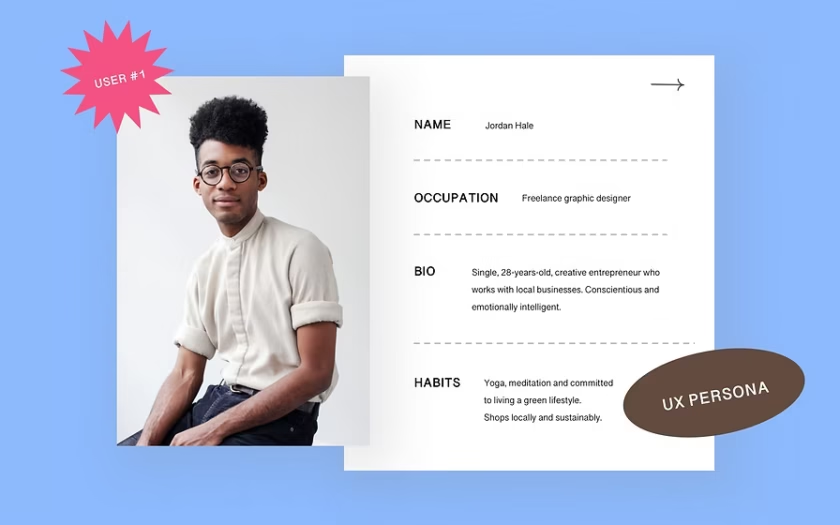Introduction
Personas are like the characters in a play—they give our designs context, motivation, and human depth. Without them, UX work risks being flat, generic, and uninspired. For years, we’ve crafted personas by conducting interviews, shadowing users, analyzing data, and stitching together the insights into relatable archetypes.
But now, we’ve got a new cast member in the mix: artificial intelligence.
AI-assisted persona creation promises speed, efficiency, and even a little bit of magic. You can feed it a dataset, a handful of survey results, or even just a prompt, and voilà: a neatly packaged persona, complete with demographics, goals, frustrations, and maybe even a fake headshot.
Sounds like a dream, right? Or maybe a nightmare.
That’s the question I want to dig into: Is AI-assisted persona creation a helpful shortcut, or a dangerous trap that risks flattening real people into lifeless stereotypes?
As someone who’s been in UX long enough to remember paper sketches taped to walls, I’ve been exploring both sides. Let’s talk about the good, the bad, and what happens when we let algorithms stand in for human empathy.
The Promise of AI in Persona Creation

I get it. Persona creation can be exhausting. If you’ve ever tried to wrangle hundreds of survey responses into something meaningful, you know what I mean. Here’s where AI shines:
- Speed & Efficiency AI can process thousands of data points faster than you can make your third cup of coffee. Instead of spending weeks sifting through raw survey results, AI can highlight patterns in minutes.
- Pattern Recognition Machine learning thrives on spotting clusters. It can reveal connections between behaviors, attitudes, and demographics that might be invisible to the human eye.
- Scalability Got a global product with millions of users? Good luck building personas from scratch. AI tools can handle massive datasets and segment users at scale, giving you a starting point to work from.
- Consistency Let’s face it—human bias can creep into persona creation. AI promises to be more “objective,” delivering personas based on data rather than the loudest voice in the room.
That’s the sales pitch. And honestly? There’s truth in it. I’ve seen AI give me valuable insights I might have overlooked on my own.
The Dark Side: When Personas Go Wrong

But here’s the rub: personas aren’t just data they’re stories. They’re about empathy, not just efficiency. And AI doesn’t actually feel anything.
Here’s where the trap lies:
- Overgeneralization
- AI can spit out personas that feel… bland. Imagine a persona named “Tech-Savvy Tina” who’s 34, shops online, and hates slow websites. Riveting, right? The danger is producing personas that are technically accurate but practically useless.
- Bias Amplification
- AI doesn’t erase human bias, it mirrors it. If the dataset it’s trained on is skewed, so are the personas. Worse, AI can give a veneer of “objectivity” to stereotypes, making them harder to challenge.
- Context Blindness
- A persona is more than just traits it’s about lived experiences. AI can miss the nuances of cultural, social, or emotional contexts that shape user behavior.
- Loss of Team Buy-In
- Half the magic of persona creation is the process itself. When a team interviews real users, debates insights, and builds personas together, they build empathy together. Skip straight to an AI output, and you lose that shared journey.
In other words, the trap is believing that because the persona looks polished, it must be accurate.
The Middle Ground: AI as a Co-Pilot

So, should we ditch AI-assisted persona creation altogether? Not necessarily. Like most tools, it depends on how you use it.
Here’s my take: AI should be a co-pilot, not the driver.
- Use AI for Data Crunching
- Let it surface clusters, patterns, and trends. Use it to accelerate the “what” so you can focus on the “why.”
- Validate with Human Research
- Don’t stop at the AI output. Test it against real interviews, observations, and qualitative data. If your AI-generated persona doesn’t sound like anyone you’ve actually spoken to, throw it out.
- Keep Personas Human
- Add texture, stories, and emotion that AI can’t generate. AI might give you the skeleton, but you need to flesh it out with human insight.
- Stay Transparent
If you’re using AI to generate personas, say so. Teams should know what’s human-created versus machine-suggested.
Done right, AI can speed up the grunt work and free you to do the high-value thinking. Done wrong, it can leave you designing for cardboard cutouts.
Resources from this article
- Nielsen Norman Group: Personas – A Simple Introduction
- Smashing Magazine: The Role of Personas in UX Design
- UX Collective: The Case Against Personas
- MIT Technology Review: How AI Bias Happens
Wrapping It Up
So, is AI-assisted persona creation a helpful shortcut or a dangerous trap? Honestly—it’s both. The shortcut comes when you use AI to speed up data analysis, highlight patterns, and give you a head start. The trap comes when you let AI personas replace the messy, human process of building empathy.
For me, the sweet spot is hybrid: AI for efficiency, humans for empathy. Personas aren’t just deliverables. They’re bridges between teams and the people we serve. AI can help us build them faster, but only we can make sure they’re real, relatable, and worth designing for.
